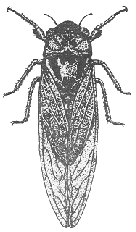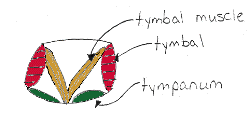
University of Kentucky Department of Entomology







How Cicadas Singby Stephanie Bailey
|
 | We've entered the dog days of summer. With the heat and humidity come the sights and sounds of the dog day cicadas. Cicadas are very distinctive, both for their large black and green bodies and for the songs they sing throughout afternoons and evenings. |
| Only male cicadas sing. Their songs are produced by two drumlike organs called tymbals, |  |
which are attached to powerful muscles on the underside of the abdomen, next to the thorax. The "eardrums" or tympana lie behind the tymbals. When the muscles attached to the tymbals are tensed and then released, the tymbals resonate, producing the characteristic song. The mechanism is similar to tapping a metal lid many times in succession.
Different species of cicadas produce slightly different songs. By "singing," the cicadas are able to congregate nearby populations of males and females of the same species.
Insects All Year cartoon courtesy of C. Ware, copyright 1998
Cicada taken from University of Kentucky Extension Publication 4DC-04SA, A Key to Insect Orders
Original drawing, S. Bailey 1997
Original document: 7 July 1997
Last updated: 5 August 1999
 Return to UK Department of Entomology Katerpillars page
Return to UK Department of Entomology Katerpillars page Return to UK Department of Entomology homepage
Return to UK Department of Entomology homepage Return to University of Kentucky homepage
Return to University of Kentucky homepage